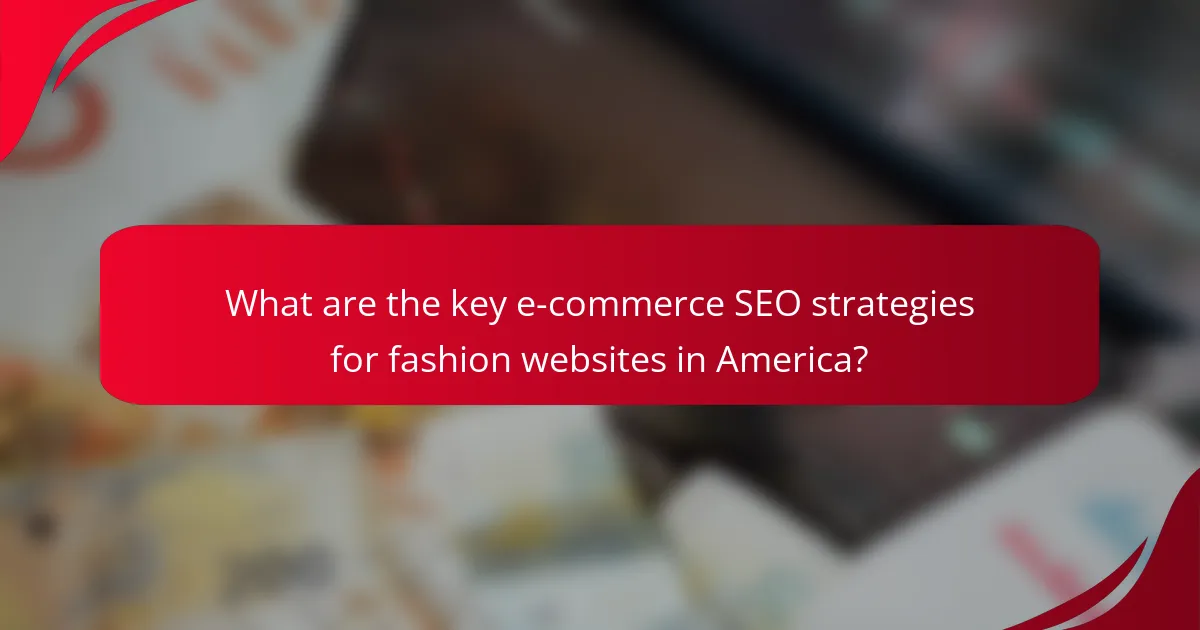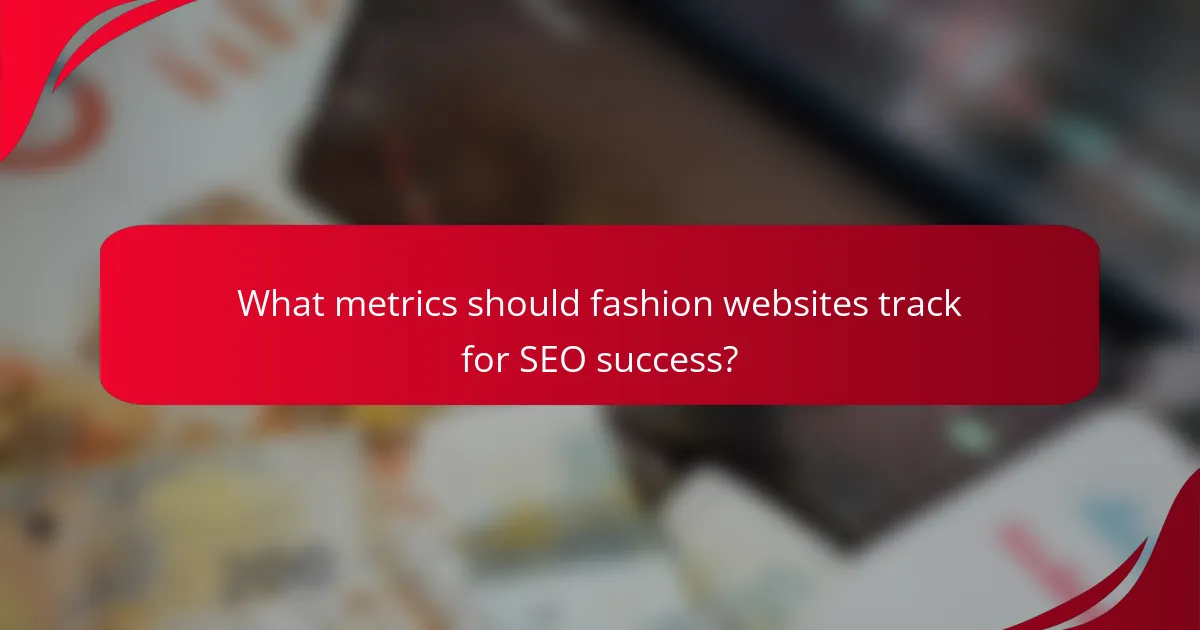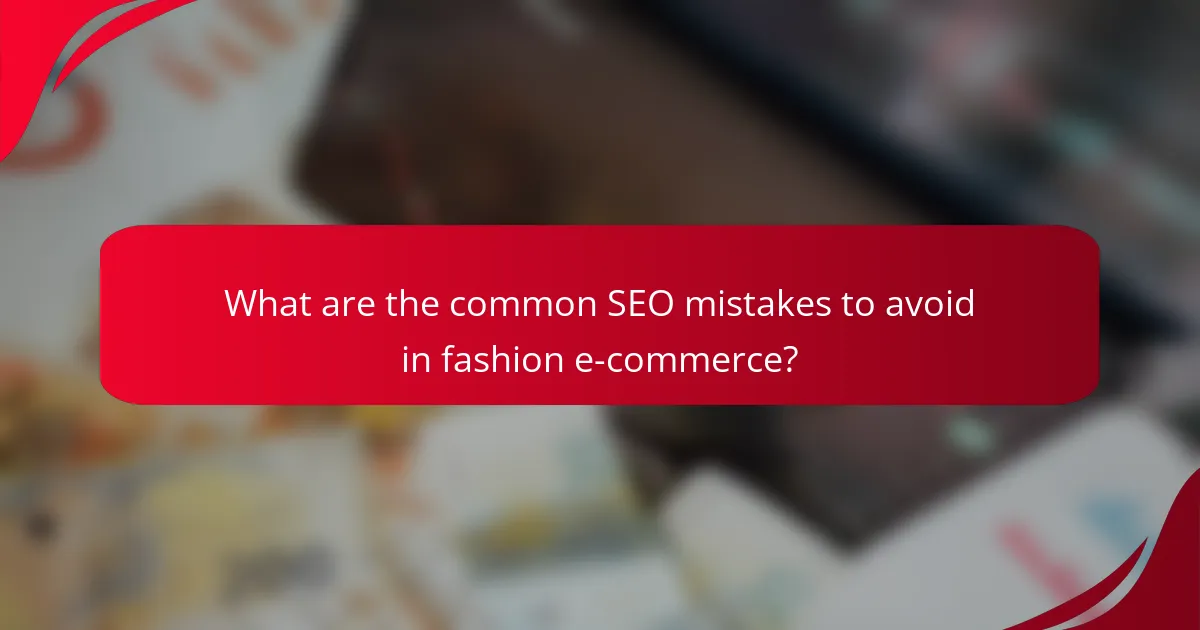In the competitive landscape of American fashion e-commerce, implementing effective SEO best practices is essential for enhancing online visibility and driving sales. Key strategies include optimizing for relevant keywords, ensuring mobile compatibility, and utilizing high-quality visuals to create an engaging user experience. By focusing on these elements, fashion brands can improve their search rankings and attract more customers to their websites.

What are the key e-commerce SEO strategies for fashion websites in America?
Key e-commerce SEO strategies for fashion websites in America include optimizing for relevant keywords, ensuring mobile compatibility, utilizing high-quality visuals, enhancing page speed, and implementing structured data. These strategies help improve search visibility and user experience, ultimately driving more traffic and sales.
Keyword optimization for fashion terms
Effective keyword optimization involves researching and selecting fashion-related terms that potential customers are likely to use. Focus on long-tail keywords that reflect specific styles, trends, or products, such as “women’s summer dresses” or “men’s casual shoes.” Tools like Google Keyword Planner can help identify popular search phrases.
Incorporate these keywords naturally into product titles, descriptions, and meta tags. Avoid keyword stuffing, as it can harm your rankings. Instead, aim for a keyword density of around 1-2% to maintain readability while still signaling relevance to search engines.
Mobile-first design principles
With a significant portion of online shopping occurring on mobile devices, adopting mobile-first design principles is crucial. This means designing your website primarily for mobile users before scaling up for desktops. Ensure that your site is responsive, meaning it adjusts seamlessly to different screen sizes.
Consider optimizing navigation for touch interfaces and minimizing loading times. A mobile-friendly website should load in under three seconds, as delays can lead to high bounce rates. Use tools like Google’s Mobile-Friendly Test to evaluate your site’s performance.
High-quality visual content
High-quality visual content is essential for fashion websites, as it significantly influences purchasing decisions. Use professional photography to showcase products from multiple angles and in various contexts. This helps customers visualize how items will look in real life.
Additionally, consider incorporating user-generated content, such as customer photos or reviews, to build trust and authenticity. Ensure that all images are optimized for fast loading times without sacrificing quality, using formats like WebP or compressed JPEGs.
Page speed optimization techniques
Page speed is a critical factor for both user experience and SEO. Aim for a loading time of less than three seconds to reduce bounce rates and improve rankings. Techniques to enhance page speed include optimizing images, leveraging browser caching, and minimizing JavaScript and CSS files.
Use tools like Google PageSpeed Insights to identify specific areas for improvement. Regularly monitor your site’s performance, as even minor changes can impact loading times. Implementing a Content Delivery Network (CDN) can also help distribute content more efficiently across various locations.
Structured data for fashion products
Structured data helps search engines understand your content better, which can enhance your visibility in search results. For fashion websites, implementing schema markup for products can provide additional information, such as pricing, availability, and reviews, directly in search results.
Utilize Google’s Structured Data Markup Helper to create and test your markup. Ensure that your structured data is compliant with Google’s guidelines to avoid penalties. This can lead to rich snippets, which can improve click-through rates and drive more traffic to your site.

How can fashion brands improve their website visibility?
Fashion brands can enhance their website visibility by optimizing their online presence through effective SEO strategies. This includes leveraging social media, building backlinks, and implementing local SEO tactics to attract more traffic and improve search rankings.
Utilizing social media integration
Integrating social media into your fashion website can significantly boost visibility. By adding social sharing buttons and embedding feeds from platforms like Instagram and Pinterest, you encourage visitors to share your content, which can lead to increased traffic and brand awareness.
Consider creating visually appealing posts that showcase your products and link back to your website. Regularly engaging with your audience through comments and messages can also foster a loyal community, further enhancing your brand’s online presence.
Building backlinks from fashion influencers
Collaborating with fashion influencers can generate valuable backlinks to your website, improving your search engine ranking. Reach out to influencers who align with your brand values and have a substantial following to create content that features your products.
When influencers share your products on their platforms, it not only drives traffic but also enhances credibility. Aim for partnerships that encourage authentic reviews and features, as this can lead to higher engagement and conversion rates.
Implementing local SEO tactics
Local SEO tactics are essential for fashion brands targeting specific geographic areas. Start by optimizing your Google My Business listing with accurate information, including your address, phone number, and business hours. This helps local customers find you easily.
Incorporate location-based keywords throughout your website content and meta tags. For instance, phrases like “women’s clothing in New York” can attract local traffic. Additionally, consider creating content that highlights local events or collaborations to further engage your community.

What role does user experience play in e-commerce SEO?
User experience (UX) is crucial for e-commerce SEO as it directly influences how visitors interact with a website, affecting both rankings and conversions. A positive UX can lead to lower bounce rates and higher engagement, which search engines recognize and reward with better visibility.
Importance of intuitive navigation
Intuitive navigation is essential for guiding users through an e-commerce site efficiently. Clear categories, well-structured menus, and visible search bars help customers find products quickly, enhancing their overall experience. Aim for a navigation structure that allows users to reach any page within three clicks.
Consider using breadcrumb trails to show users their current location within the site hierarchy. This not only aids navigation but also improves SEO by providing additional context to search engines about your site’s structure.
Impact of site layout on conversion rates
The layout of an e-commerce website significantly impacts conversion rates. A clean, visually appealing design with strategically placed call-to-action buttons can encourage users to complete purchases. Ensure that product images are high-quality and that descriptions are concise yet informative.
Test different layouts through A/B testing to determine which design elements yield the highest conversion rates. Focus on minimizing distractions and ensuring that the checkout process is straightforward, as complicated steps can lead to cart abandonment.

What metrics should fashion websites track for SEO success?
Fashion websites should track several key metrics to gauge their SEO success, including organic traffic, conversion rates, and engagement metrics. Monitoring these indicators helps identify areas for improvement and optimize strategies for better visibility and sales.
Organic traffic growth
Organic traffic growth measures the number of visitors coming to your fashion website through unpaid search results. A steady increase in this metric indicates that your SEO efforts, such as keyword optimization and quality content, are effective.
To track organic traffic, use tools like Google Analytics to monitor trends over time. Aim for a growth rate of at least 10-20% annually, adjusting your strategy based on seasonal trends in the fashion industry.
Conversion rate analysis
Conversion rate analysis focuses on the percentage of visitors who make a purchase after visiting your site. This metric is crucial for understanding how well your website turns traffic into sales.
To improve conversion rates, consider A/B testing different elements such as product descriptions, images, and calls to action. A typical conversion rate for e-commerce sites ranges from 1-3%, so aim to optimize your site to reach or exceed this benchmark.
Bounce rate and engagement metrics
Bounce rate measures the percentage of visitors who leave your site after viewing only one page. A high bounce rate may indicate that your content is not engaging or relevant to visitors.
To lower bounce rates, ensure your website loads quickly and provides valuable content that meets user expectations. Aim for a bounce rate below 40%, and track engagement metrics like average session duration and pages per session to assess user interaction.

How can fashion websites leverage content marketing for SEO?
Fashion websites can enhance their SEO through strategic content marketing by creating engaging and relevant content that attracts and retains customers. This approach not only boosts organic traffic but also establishes brand authority and improves search engine rankings.
Creating style guides and lookbooks
Style guides and lookbooks serve as visual and textual resources that help customers understand how to wear specific pieces. By showcasing outfits and styling tips, fashion websites can create shareable content that resonates with their audience. Incorporating keywords related to seasonal trends and popular styles can further improve SEO performance.
When developing these guides, consider including high-quality images and links to purchase featured items. This not only enhances user experience but also encourages conversions.
Blogging about fashion trends
Blogging about current fashion trends allows websites to tap into timely topics that attract search interest. Regularly updating a blog with articles on trends, styling advice, and fashion news can drive consistent traffic. Aim for a mix of evergreen content and timely posts to maintain relevance.
Utilize keywords that potential customers are searching for, such as “fall fashion trends” or “sustainable fashion tips.” Engaging headlines and informative content can help improve click-through rates and keep readers returning for more.
Utilizing video content for product showcases
Video content is an effective way to showcase products in action, providing a dynamic view that static images cannot match. Fashion websites can create videos demonstrating how to style items or featuring behind-the-scenes looks at collections. This type of content can significantly enhance user engagement and dwell time on the site.
Make sure to optimize video titles and descriptions with relevant keywords and include links to products. Platforms like YouTube can also serve as additional channels for driving traffic back to the main website.

What are the common SEO mistakes to avoid in fashion e-commerce?
Fashion e-commerce websites often make critical SEO mistakes that can hinder their visibility and sales. Key errors include neglecting mobile optimization, overlooking keyword research, and failing to optimize product images.
Ignoring mobile optimization
Neglecting mobile optimization can severely impact a fashion e-commerce site’s performance, as a significant portion of online shopping occurs on mobile devices. Websites that are not mobile-friendly may experience higher bounce rates and lower conversion rates.
To ensure mobile optimization, use responsive design that adapts to different screen sizes. Test loading speeds, as mobile users typically expect pages to load in under three seconds. Tools like Google’s Mobile-Friendly Test can help identify issues.
Common pitfalls include using large images that slow down loading times and having complex navigation that is difficult to use on smaller screens. Prioritize a clean, simple layout that enhances user experience on mobile devices.










